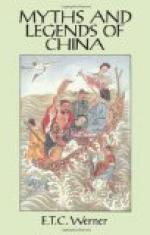In some of the pictures of P’an Ku he is represented, as already noted, as holding the sun in one hand and the moon in the other. Sometimes they are in the form of those bodies, sometimes in the classic character. The legend says that when P’an Ku put things in order in the lower world, he did not put these two luminaries in their proper courses, so they retired into the Han Sea, and the people dwelt in darkness. The Terrestrial Emperor sent an officer, Terrestrial Time, with orders that they should come forth and take their places in the heavens and give the world day and night. They refused to obey the order. They were reported to Ju Lai; P’an Ku was called, and, at the divine direction of Buddha, wrote the character for ‘sun’ in his left hand, and that for ‘moon’ in his right hand; and went to the Han Sea, and stretched forth his left hand and called the sun, and then stretched forth his right hand and called the moon, at the same time repeating a charm devoutly seven times; and they forthwith ascended on high, and separated time into day and night. [5]
Other legends recount that P’an Ku had the head of a dragon and the body of a serpent; and that by breathing he caused the wind, by opening his eyes he created day, his voice made the thunder, etc.
P’an Ku and Ymer
Thus we have the heavens and the earth fashioned by this wonderful being in eighteen thousand years. With regard to him we may adapt the Scandinavian ballad:
It was Time’s morning
When P’an Ku lived;
There was no sand, no sea,
Nor cooling billows;
Earth there was none,
No lofty Heaven;
No spot of living green;
Only a deep profound.
And it is interesting to note, in passing, the similarity between this Chinese artificer of the universe and Ymer, the giant, who discharges the same functions in Scandinavian mythology. Though P’an Ku did not have the same kind of birth nor meet with the violent death of the latter, the results as regards the origin of the universe seem to have been pretty much the same. [6]
P’an Ku a Late Creation
But though the Chinese creation myth deals with primeval things it does not itself belong to a primitive time. According to some writers whose views are entitled to respect, it was invented during the fourth century A.D. by the Taoist recluse, Magistrate Ko Hung, author of the Shen hsien chuan (Biographies of the Gods). The picturesque person of P’an Ku is said to have been a concession to the popular dislike of, or inability to comprehend, the abstract. He was conceived, some Chinese writers say, because the philosophical explanations of the Cosmos were too recondite for the ordinary mind to grasp. That he did fulfil the purpose of furnishing the ordinary mind with a fairly easily comprehensible picture of




